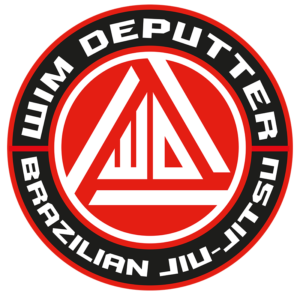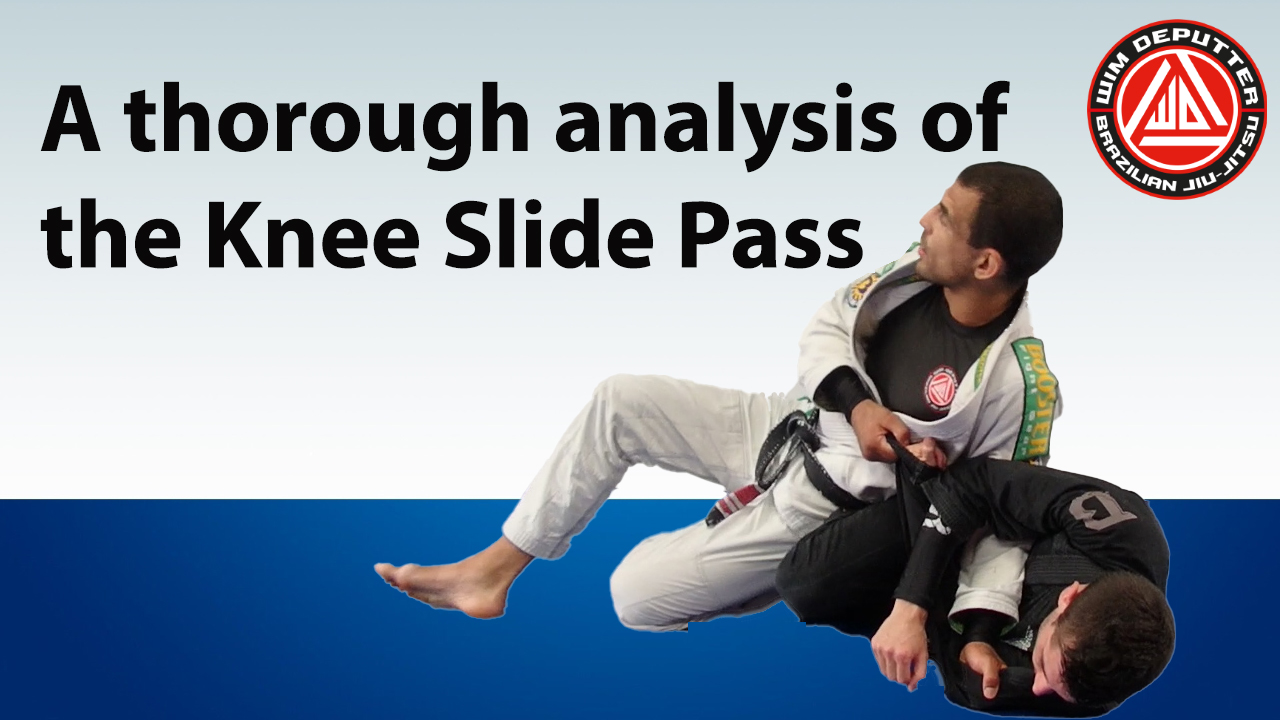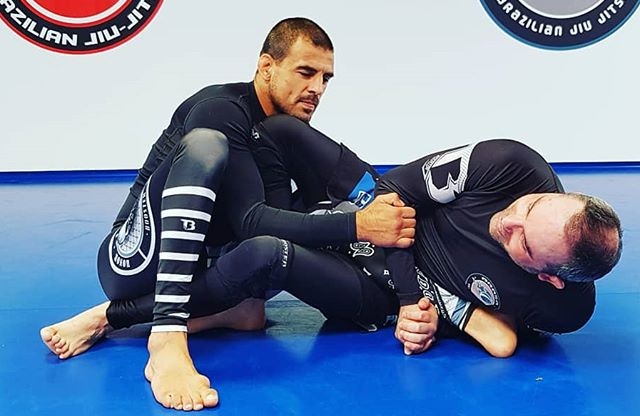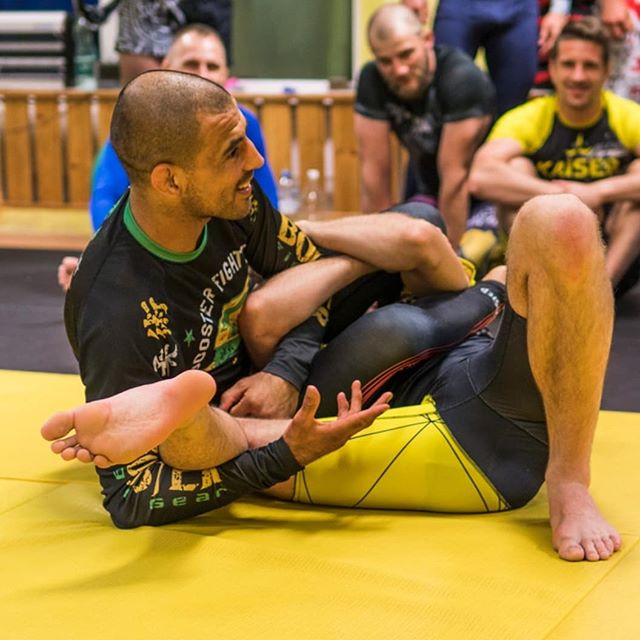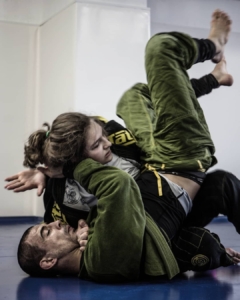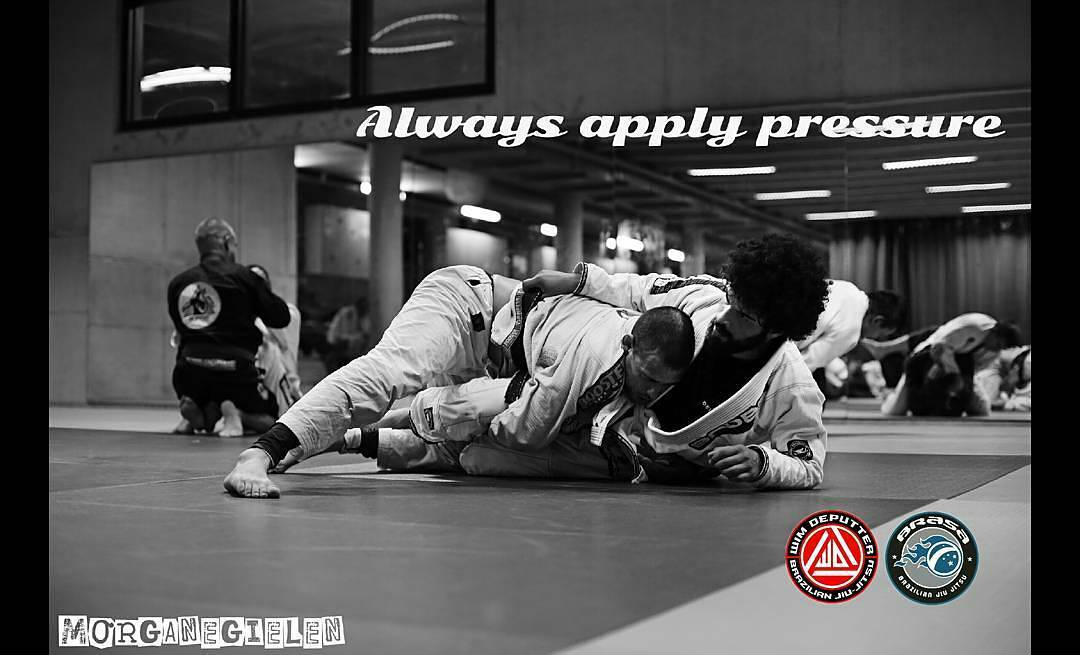Enter ‘The Rocking Chair’ – Counter for one of the most common passes in Brazilian Jiu Jitsu
Are you a half guard player? Does your guard often get passed with the knee cut?
Do this adjustment and turn the situation to your advantage!
The knee cut, knee slice, knee slide, cut through pass,… however you call it, it’s a guard pass every half guard player will have to learn how to deal with. It’s one of the most common passes in Brazilian Jiu Jitsu at every level.
The regular way to play deep half guard, is to fight for the underhook and reach for an undergrip on the far leg.
Once the opponent starts to cut his knee through, there is a gap behind his leg. This allows you to let the far leg go and instead weave your bottom arm behind the cutting leg. Congratulations! You just entered “The Rocking chair” 🙂 Not only did you counter the knee cut guard pass, from here you can also transition to a modified Dogfight.
From Dogfight you have a lot of options, which I will explain the next few weeks in my “The Rocking Chair”-series.
Stay tuned! 🙂
Check out part 1 Wim Deputter‘s next series: Enter “The Rocking Chair”
The hack to make you understand Jiu Jitsu and improve faster
There is a hidden framework in Jiu Jitsu. The red line through all of your techniques. The bjj unifying principle that all techniques have in common. Learn this and it’s like a hack that makes you understand jiu jitsu faster.
What do all techniques have in common?
The way your core, your body moves.
In jiu jitsu we have to learn to exert strenght with our core. Our frames (arms and legs) are merely conductors that transmit the pressure from our core to our opponent. If we keep our frames rigid and our body connected, every movement we make, will be felt by our opponent.
If we realize that movement is so important, it makes sense that we have to move as efficient as possible. The most effective way to apply pressure on our opponent, is by using rotation from the core.
If our frames are conductors, then our core is like a battery; it’s the one part of our body that can generate strength most efficiently with minimal exercition.
In this video I will show you how to rotate as effectively as possible. It is shown here from a defensive perspective. The challenge for you is to see the applications in offense and reactions on top that counter it.
This is a perfect introduction to my BJJ Fanatics instructional: ‘A General Introduction to the Mirroring Principle and the Babybridge’.
In the next video, you can see an example of how this sequence can by used offensively by Cody Maltais.
A common problem, and serious threat, when holding the guillotine in bottom side control, is the Von Flue Choke. Cody shows how you can not only use the Babybridge to defend the Von Flue Choke, but also use ‘Head – Shoulder – Knees and Toes’ sequence, to get back to your knees, while mantaining the guillotine. This way you can keep a constant threat.
Be sure to check out the rest of my channel. Don’t forget to give a thumbs up and subscribe!
If you see other applications of this concept or anything else I show on my channel, feel free to send me 🙂
“Have as much fun defending from ‘bad’ positions as you have attacking from ‘good’ positions. Panicking, spazzing and disconnecting are the opposite of what is jiu jitsu.
You are on this mat to learn jiu jitsu.
No matter if you are in a ‘good’ or ‘bad’ position, you can still be doing jiu jitsu.”
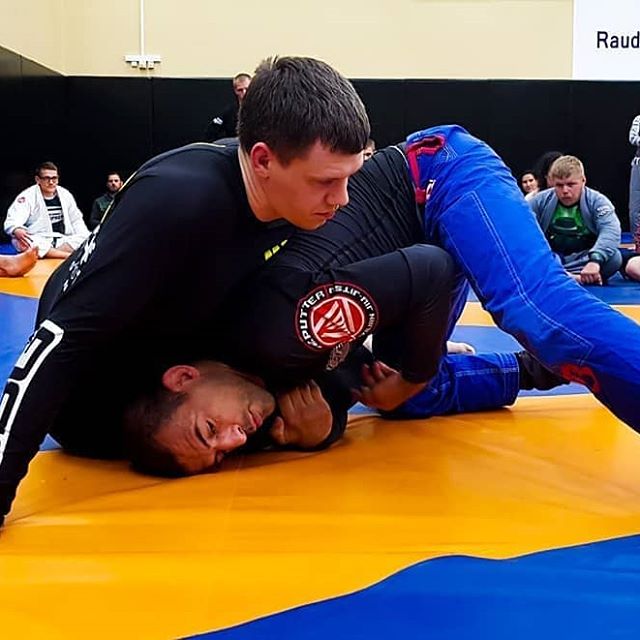
Who is “attacking” and who is “defending” in this photo? The ‘”fireman” position is one of the pillars in Wim Deputter’s “Mirroring Principle”
That is the first piece of advice I give beginners on my mat these days. And, if I could go back in time, it is the one piece of advice I would give to my white belt self.
Offensive Defense – Defensive Offense
There are no ‘good’ or ‘bad’ positions in jiu jitsu.
Only positions you know what to do or don’t know what to do.
In some positions you can be less mistakes away from tapping than your opponent.
But if you don’t make mistakes and do the right thing at the right time, you can make every position work.
By truly believing that, you are more inclined to look up “weird” or “losing” positions.
This gives you a better chance to fight from those weird positions than people who hold dogmatic believes.
The photo below was taken at a seminar I taught at Kaiser Sports in Olzstyn, Poland last year. Take a close look at the exact armbar position of Przemysław (partner on bottom).
It’s hard to believe, but from everything that I “discovered” so far the last few years, it’s actually harder to finish the submission here, than it is to escape (given no mistakes are made).
Often when people think about escaping, they think about disconnecting and getting away from the “dangerous” position.
By doing this, you will get at best a reset to a neutral position.
“Offensive defense” means staying connected. Don’t try to get away from, but instead, spend time in the “dangerous” positions.
Figure the positions out and try to solve them, not escape or break them. Make defense seamlessy transition into offense and bypass the neutral reset. Find the logic in every position.
The more disconnected two grapplers are, the more possibilities of movement there are, the more chaos.
Explosive and strong people hold a significant advantage over weaker people in most grappling related circumstances. The more disconnected a position is, the exponentially bigger that advantage is. The more connection, the least possibilities and chaos. More connection means more predictable. The more predictable the situation, the more the methodical technical grappler can shine.
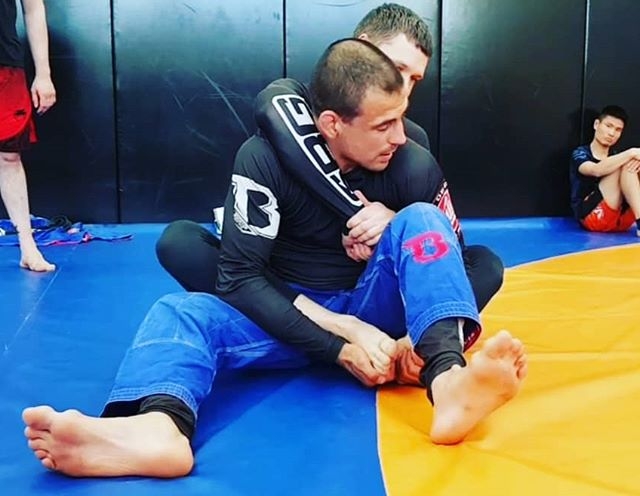
If you have a good understanding of back defense, playing “panda” is easier than it looks. Click the photo for The Mirroring Principle “Backdefense and being offensive with someone on your back”.
Offensive Defense
Offense is starting from a ‘good’ position and slowly working your way towards a ‘better’ position. Defense is starting from a ‘bad’ position and slowly working your way towards a ‘better’ position. Both offense and defense are a battle for improvement and they meet in the neutral point were neither holds an advantage.
From this perspective, there is no difference between offense and defense.
You can’t teach offense without being aware of the defense, you can’t teach defense without being aware of the offense. Stay connected and realize they are both one and the same.
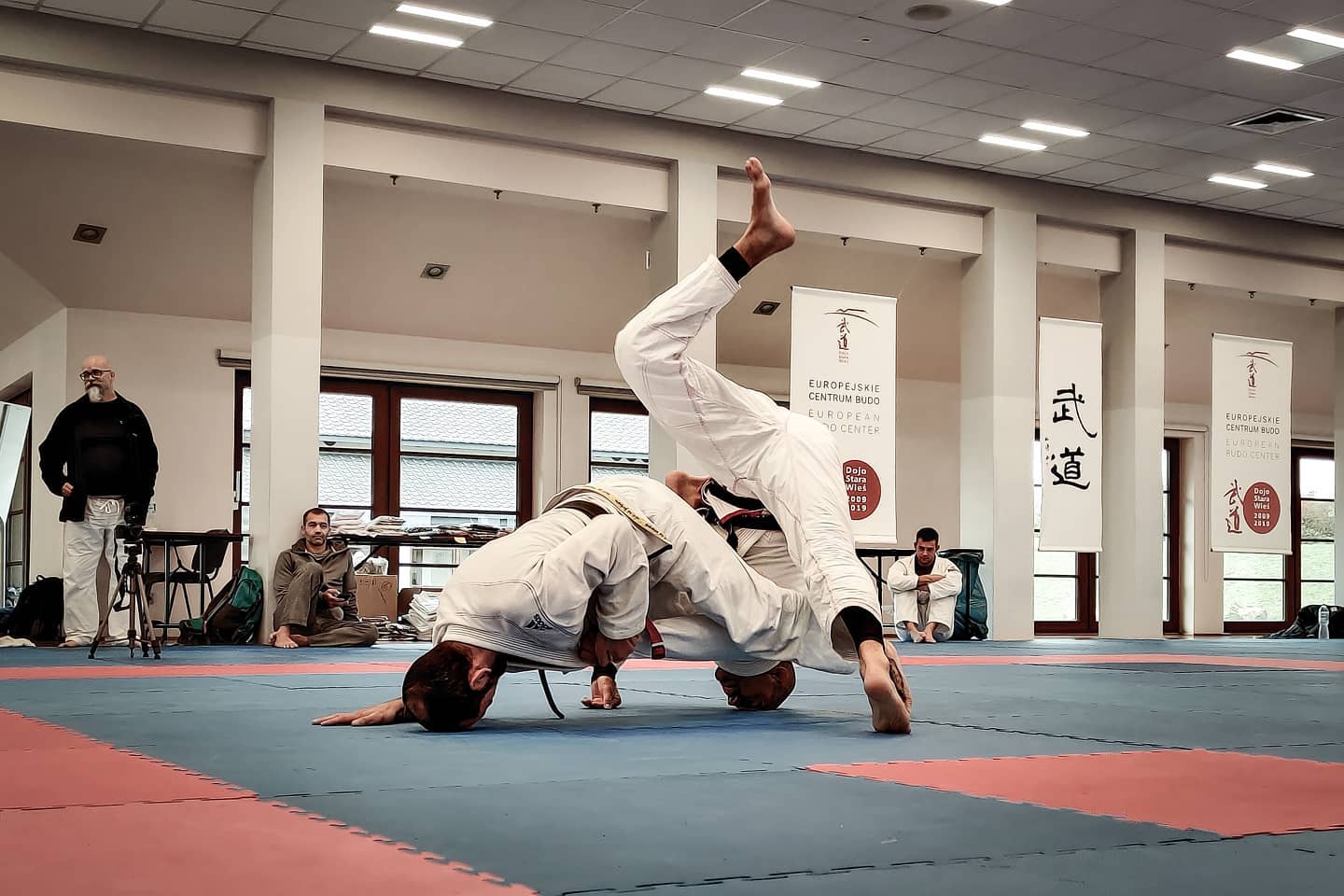
Wim Deputter defending a sweep attempt with a headstand at the BJJ Globetrotters Zen Camp 2020, foto by Crisitiana Theodoli
Sweeps don’t work!
…or they get easier to defend at least if you have a great headstand 🙂
Check out the video’s in my “Unsweepable” series and learn how defend and counter the most common sweeps!
In this playlist I will go over the mechanics of a proper headstand, how you can use that headstand to become much harder to sweep, a counter to the classic scissor sweep and much more…
Let me know what you think in the comment section. Sharing is caring 😉
The Mirrorring Principle
Unsweepable by Wim Deputter
This is how I roll – The Mirroring Principle by
Whenever I roll on training with someone I don’t know…
I like to start standing, let them get their grips and let them choose top or bottom.
Training is not always to see if I can beat someone with my A game.
It’s most often to check if I can play your game, defend myself and still come out on top.
The harder people go, the calmer I go. When they go hard (and they often do ?) they get tired in the first few minutes. I keep pushing the same pace.
When it’s someone who goes slow as well, we have a nice technical roll. You build respect and trust for later, more higher paced rolls.
If I can allow someone’s A game while rolling calm and still come out on top. I know I can do the same thing playing my A game.
I train seven days a week, never refuse a roll with anyone, never sit a round out and usually take the first roll with new students. This way you meet all kinds of people. Some aggressive, some calm, some heavy and some light.
This is the safest way to train jiu jitsu and be ready for anyone facing you. Probably the only way you can train a lifetime with minimal injuries.
Along the way you might even convince some douches to take the same approach and ultimately make rolling safer for everyone. Creating an environment where you can safely take risks. Taking risks, allowing bad positions, getting out of your comfort zone are the only way to learn.
It sets an example for beginners. If we roll hard, they will copy that. If we roll slow and technical, they will copy that.
Before a hard roll, you have to build trust and respect first.
Competition is for testing yourself against people you haven’t build trust with yet.
The Mirroring Principle training philopophy
Wim Deputter
The Rules of Pressure in Jiu Jitsu
Moving the body of your opponent requires energy, especially if it’s a strong person.
Instead of moving your opponent, be tight; get a grip, bring your elbows to your hips and your hips to your elbows, turn in a hip.
Make it hard for your opponent to move because of your pressure. Make your pressure so unbearable he has to move. Make it so tight every move he makes, costs him energy.
When your opponent has moved, the situation has slightly changed, adapt to the new situation by changing your grip(s) and move yourself a bit closer, maybe turn in the other hip. Keep repeating this pattern and thus climb the ladder, inch by inch closer to your goal: submitting your opponent.
